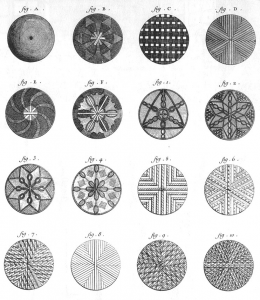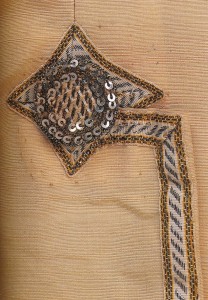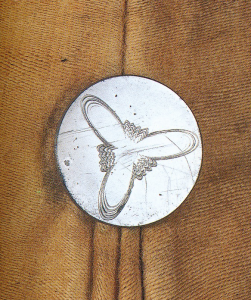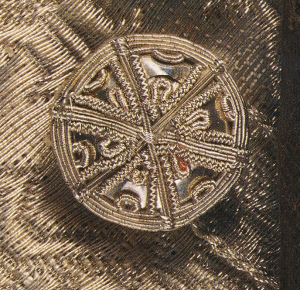Button designs became more complex during the eighteenth-century than they had been in previous times. During this period, buttons started coming in all different materials, though most of the ones owned by the wealthy were made of pearl, gold, silver, copper, or a wooden core covered with other decorations, including silver thread, foil, silk threads and cords, satin stitching, and spangles (thin disks of metal for decorating clothing). The most expensive buttons were hand-decorated to adorn cuffs, sleeves, jacket fronts, and reinforce pleating, though some buttons were purely decorative. While most buttons were round, some were made in the shape of a cross, almond, spiral, or square.
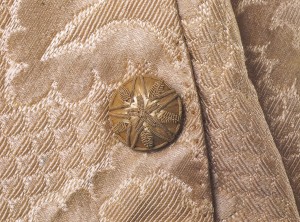
Button from a man’s coat made from silk thread over a wooden core. Note how the button matches the fabric behind it
The highest quality buttons were made with a wooden mold that provided shape, and was domed, knobbed, or notched to hold the decorative foil and thread that would be stretched across it. The various materials used to cover the wood were meant to shine and compliment the fabric behind it. Spangles were particularly effective in drawing a viewer’s eye to the centers of buttons, around which were often intricately embroidered patterns. The colors used in the buttons were also meant to match the rest of the outfit. Not only were the buttons themselves elaborate in design, but there was often decoration on the fabric behind the button to accent it. The stitching also sometimes helped reinforce the button or other elements of the clothing, such as the pleats. Button makers had to be creative in their designs—even when buttons adorned the same outfit, each sometimes had to be different!
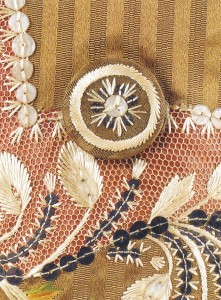
An example of a spangled button, with elaborate embroidery and additional spangling on the support fabric
For the less wealthy, buttons were stone, pewter or gilt brass, made from a mold rather than by hand. Craftspeople could stamp out buttons, or engrave them with a machine through the “engine turning process.” This process allowed designs to be incised in the buttons with a “rosette” disc connected to a lathe (a mechanical tool used by ivory, wood, and metal workers to rotate and shape materials). The same technique was used to decorate silver boxes during this period. While this type of button did not show the same level of fine craftsmanship, it could still sport complicated patterns. Additional techniques to create such decorations included hammering and chasing (adding grooves).
The molding process was also used to create pure gold, silver, and copper buttons. These buttons were usually concave and filled with other precious metals. The button-makers had to collaborate with metal-workers, who would melt and pour the metal into the mold. It could then either be sent to an engraver, or other objects could be embedded in the metal as it hardened. This type of button was called “bouton plané.”
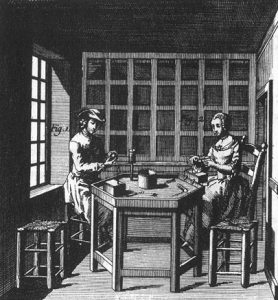
Encyclopédie plate of button makers decorating buttons with silk. The table is typical of what would be used, and normally six makers could fit around it at once
The materials used to make the buttons indicated the wealth of the wearer. Gold buttons came in different qualities, and had to be polished to shine. The finest silk from the Piémont region in France could be used to imitate this brilliance, and was sometimes placed underneath lower-quality gold. Silk buttons were sewn onto the garment with silk thread, but heavy buttons were sewn on with a mixture of horse hair and silk string (two hairs to one silk thread). Button-makers would have been adept at working with many materials to create intricate designs, and collaborating with other artisans to make unique and valuable works.
For more information on buttons, please see:
Diderot, Denis, and Jean Le Rond d’Alembert. Encyclopédie Ou Dictionnaire Raisonné Des Sciences, Des Arts et Des Métiers. Geneve: J.L. Pellet; [etc.], 1778.
Hart, Avril, and Susan North. Seventeeh and Eighteenth-Century Fashion in Detail. London: V&A Publishing, 1998.
Starobinski, Jean, Philippe Duboy, Akiko Fukai, Jun I. Kanai, Toshio Horii, Janet Arnold, and Martin Kamer. Revolution in Fashion 1715-1815. Edited by Amy Handy. New York: Abbeville Press, 1989.
Image citations:
Diderot, Denis, and Jean Le Rond d’Alembert. Encyclopédie Ou Dictionnaire Raisonné Des Sciences, Des Arts et Des Métiers. Geneve: J.L. Pellet; [etc.], 1778.
Hart, Avril, and Susan North. Seventeeh and Eighteenth-Century Fashion in Detail. London: V&A Publishing, 1998.


